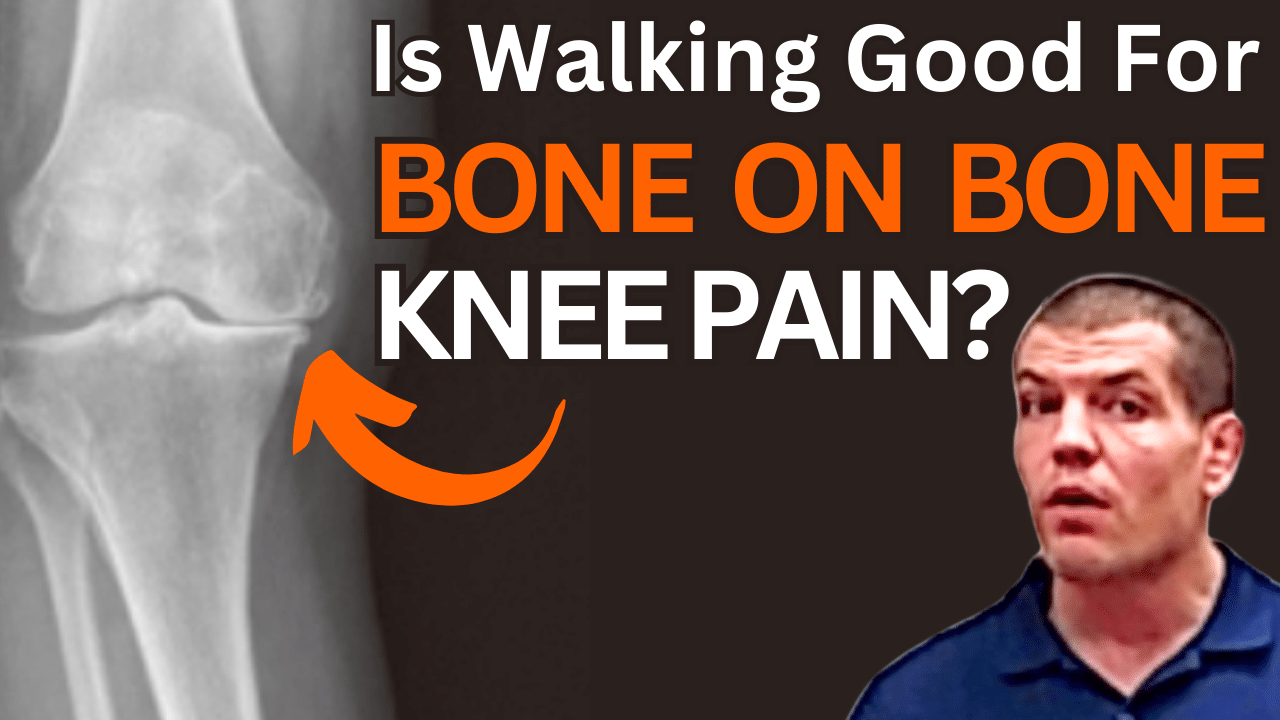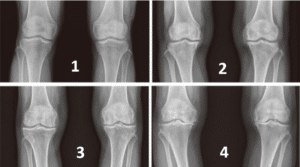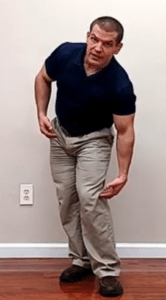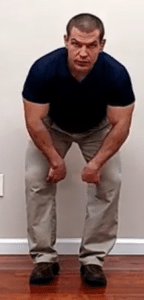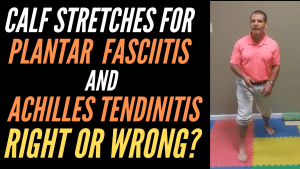Walking is almost always good for knee arthritis, even if you have bone on bone knee pain. Watch the video to learn what it really means to have bone on bone knee pain. Plus, learn what you can do to have less knee pain when walking even if you have knee arthritis.
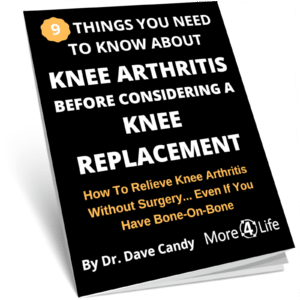
What is Bone on Bone Knee Pain?
What exactly does bone-on-bone knee pain mean? When you have knee arthritis, a lot of times doctors will refer to it as bone-on-bone.
However, there are actually four different grades of knee arthritis.
Knee arthritis is graded using a 5-point scale called the Kellgren-Lawrence Scale.
On that scale, grade 0 represents a normal knee with no knee arthritis and grades 1-4 are increasingly severe grades of arthritis.
What Are The 4 Grades Of Knee Arthritis?
According to the knee arthritis grading scale developed by Kellgren and Lawrence in 1957, these are the grades of knee arthritis:
- Grade 0: normal knee
- Grade 1: doubtful joint space narrowing and possible bone spurs
- Grade 2: definite bone spurs and possible narrowing of joint space
- Grade 3: moderate multiple bone spurs, definite narrowing of joint space, some thickening of the bone under the cartilage
- Grade 4: large bone spurs, marked narrowing of joint space, and changes of the ends of the bones under the cartilage
Essentially in Grade 4 knee arthritis, you have "bone-on-bone" of the thigh bone (femur) and lower leg bone (tibia) without cartilage between.
When you have the bone rubbing on the bone without cartilage in between, that can create friction and inflammation.
That inflammation can cause some knee pain when you're walking, but that doesn't necessarily mean that walking is a bad thing for you to do.
If you have the lower grades of knee arthritis - grade one, two, and three - walking is actually really good for cartilage health.
This is because when you move your knee and you bend it back and forth and you bear weight on it, it squeezes a lubricating fluid out of the cartilage surfaces.
This synovial fluid helps lubricate the joint and make it move a little bit more easily without as much pain or friction.
If you have grade four or bone-on-bone knee pain, since the cartilage is worn down, you don't get that release of synovial fluid.
However, walking is still good for bone-on-bone knee pain.
The reason for that is that it helps you maintain your mobility and independence in daily activities.
Regardless of whether or not you decide to have a knee replacement, if you stop moving, your muscles get weaker and deconditioned over time.
Therefore, the less you walk, the harder it gets to walk.
Remember that humans lived for thousands of years before knee replacements were invented, so no one really needs a knee replacement per se.
That being said, if you do have bone-on-bone, grade four knee arthritis, a knee replacement can be helpful to allow you to move around a little bit more comfortably.
However...
Surgery Is NOT Always Needed For Bone On Bone Knee Pain
There may be some cases where you decide that knee replacement isn't a good fit for you.
Maybe you just don't like the risk of surgery.
Or maybe you're not a good surgical candidate due to other medical issues like heart problems, uncontrolled diabetes, obesity, bleeding or clotting disorders, or osteopenia / osteoporosis.
Furthermore, the strongest predictors of chronic pan AFTER a knee replacement are higher levels of preoperative pain, poor mental health (i.e. anxiety and depression), and pain catastrophizing (expecting the worst).
So if you have any of these factors, you might want to think twice (or more) about having a knee replacement.
That's not to say you shouldn't do it, but at least exhaust your conservative options first.
What Does Bone On Bone Knee Pain Feel Like?
Some of the most common things that people feel when they have knee arthritis are:
- pain around the kneecap pain (patellofemoral pain)
- pain on the inside of the knee, or
- pain on the outside of the knee
However, those problems actually aren't caused by the bone-on-bone knee arthritis.
The pain that you get from bone-on-bone arthritis is usually deep inside the joint.
You usually can't touch bone-on-bone knee pain.
It's where the two bones grind together, and it's inside your knee joint capsule.
So, if you're having pain on the inside of your knee, the outside of your knee or the front of your knee, that's unlikely to be caused by the actual joint problem.
This means even if you have bone-on-bone knee arthritis, you could still have a knee replacement and possibly still have pain afterward if the knee joint is not the cause of your pain.
X-Rays and MRIs Don't Tell The Full Story Of Knee Pain
It is important to remember that X-rays and MRIs don't always predict who is in pain and who isn't.
There are people who have severe damage in their back, knee, or shoulder according to their X-rays or MRIs, but they have no pain at all.
Conversely, some people have pristine-looking X-rays and still experience a lot of pain.
Therefore, it is crucial to ensure that the knee pain you're experiencing is coming from inside the joint, even if you have bone-on-bone knee arthritis on your x-ray.
What Causes Bone On Bone Knee Pain When Walking?
One of the most common causes of knee pain when walking is overpronation.
Pronation means the flattening out of your foot that occurs when you load weight onto your foot while walking.
Pronation is a natural part of walking and helps with shock absorption.
However, too much pronation isn't good.
When your foot flattens out too much, it causes your knee to bend inward. This creates an abnormal bending force on the knee joint.
The tissues on the outer side of the knee joint get compressed and the tissues on the inner side of the knee joint get overstretch.
If you have bone-on-bone knee arthritis on the outside of your joint, overpronating can compress the cartilage on outside of the knee joint.
Conversely, it's more common to get bone-on-bone knee arthritis on the inside of the knee.
When you have knee cartilage loss on the inside of the knee, you can develop a bow-legged deformity.
This creates compression on the inner side of the knee joint.
In that case, your feet hit the ground in a supinated (high-arch) position.
In theory, pronating the feet should gap the inner side of the joint and help create more space within the joint.
The problem is though, if your knees are bow-legged, it forces your feet to hit the ground in a supinated position and then rapidly pronate in order to get your big toe down to the ground.
This pronation under-weightbearing causes twisting of the knee joint. If you already have bone-on-bone arthritis in your knee joint, this twisting motion grinds the joint surfaces together and can cause inflammation and pain.
How To Relieve Bone On Bone Knee Pain When Walking
Control Pronation
If you overpronate, one easy thing to do is hit a little bit more on the outside of your foot when walking. This can line up your knee in a straight position and prevent if from going inward.
It also helps to curl your toes to help lift your arch and keep your foot from flattening out excessively.
Shorter Steps
Many people get knee pain when walking because their calves are tight.
When taking a step, the tightness in your calf can prevents you from getting your bodyweight to move in front of your foot.
This causes you to find an alternate route around the problem, which is often overpronation, where your foot turns outward and your knee goes inward.
Taking shorter steps can help you walk more comfortably in the short term without hurting your knee.
Stretch Your Calves
Ultimately in the long run though, you do want to improve your calf flexibility so that you can take more normal length steps.
You can stretch your calves by standing with one foot forward and one foot back with both heels flat on the floor. Learn how to do calf stretches properly here.
Improve Your Balance
Taking shorter steps also solves another common problem that causes knee pain, which is weakness in the hip.
If you have trouble balancing your body over one leg, your knee goes inward, creating an abnormal valgus force on your knee.
Taking shorter steps reduces the amount of time you spend on one leg and, therefore, doesn't require as much hip strength. So it's a good short-term fix for bone-on-bone knee pain.
Again though, for better long-term results, you do want to get your hip stronger and improve your balance.
One good way to do that is just to practice balancing on one leg.
Turn Your Toes Out
Although you don't want your toes to turn out a s a result of poor calf flexibility, some people are built with a bone structure where their knees naturally turn out.
In this case, you don't want to force your toes to point straight ahead if that's not the way your body developed.
So if you naturally tend to toe out, walking with your toes outwards can help relieve bone-on-bone knee pain when walking.
When walking like this, think about leading with your heel.
Walking this way may look a little weird, but it helps align your hips correctly, putting less stress on your knees.
And honestly, no one else besides you will probably notice.
I feels strange, but other people are too busy going on about their day to worry about or care how it looks if you're walking with your toes turned out.
So if it helps you walk more comfortably, try walking with your toes turned out and leading with your heel.
Can Braces Help Bone On Bone Knee Pain When Walking?
Most slip on knee sleeves or knee braces don't do much to help bone-on-bone knee pain.
Bone-on-bone knee pain is caused by compression of the two joint surfaces between the femur and the tibia when loading weight on the knee.
Therefore to relieve the pain a brace would need to take compression OFF of the knee.
And there are actually some knee braces that do that.
Most "knee unloader" braces are designed to unload either the inner or the outer compartment of the knee by bending the knee sideways.
However, the downside of that is that while it unloads one side of the knee, it compresses the compartment on the opposite side of the knee.
Here's one such Knee Arthritis Unloader Brace by Orthomen.
As you can see, it only has a bar on one side of the knee. This design allows it to bend the knee sideways.
However, I recently came upon another knee unloader brace that unloads BOTH compartments of the knee.
Here's a review of that knee brace so that you can see it in action and learn how it works.
If you like the brace, you can buy the Knee OA Pro directly from DDS and save 10% using my discount code "DRCANDY10".
Or you can buy it on Amazon at full price.
Transparently, both of these are affiliate links so I earn a commission if you purchase through the links, but I only promote products that I actually believe are helpful.
Conclusion
So those are my tips to help you walk more comfortably if you knee arthritis.
Remember, walking is good for your knees, even if you have bone-on-bone knee pain.
You just want to make sure that you're walking in a manner that's best for your body's structure.
If you need help to be able to relieve knee arthritis pain and be able to walk more comfortably, we'd be happy to help you at More 4 Life.
Just tap the button below to request an appointment with one of our specialists.

